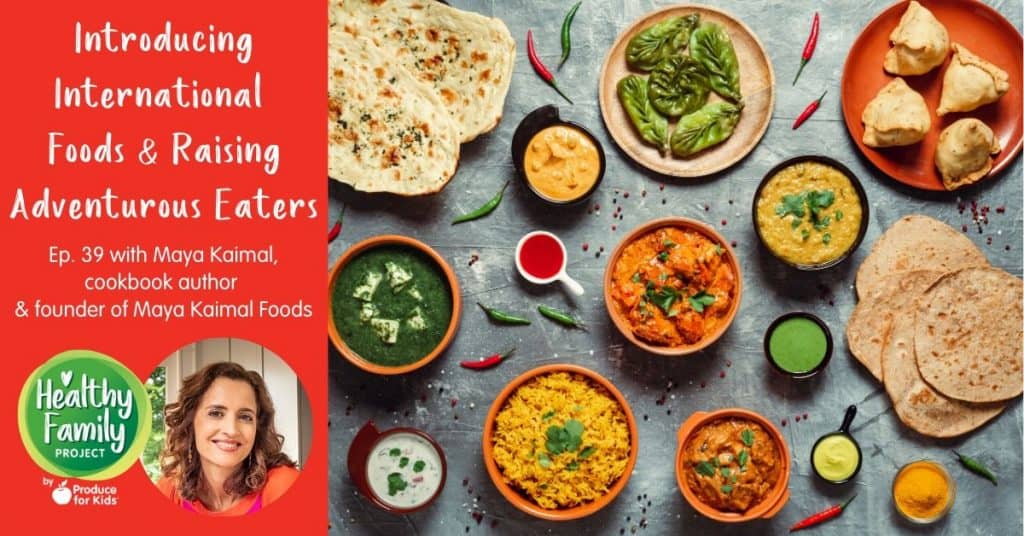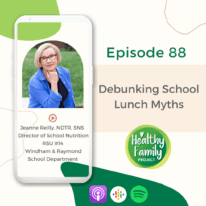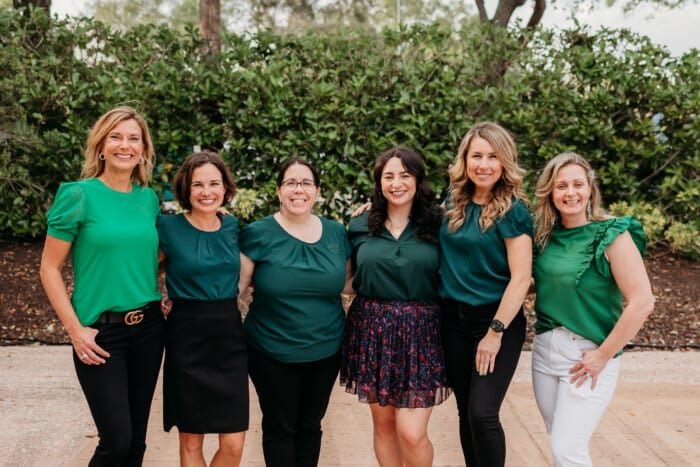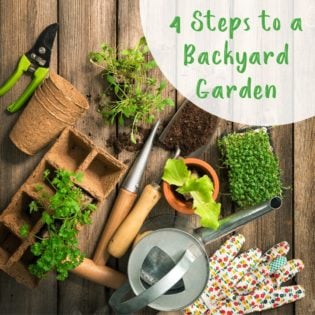Episode 39: Introducing International Foods & Raising Adventurous Eaters

In this episode of Healthy Family Project, we talk to Maya Kaimal, award-winning cookbook author and founder of Maya Kaimal Foods, about how to easily add international foods to your menu and introduce them to your selective eaters. Maya shares ways to incorporate worldly flavors in a kid-friendly way while using it as a teaching opportunity to learn about different cultures.
Raised in Boston by a South Indian father and a mother from New England, Maya grew up in a multi-cultural home filled with delicious and diverse foods. Her father’s Indian cooking combined with trips to visit family in India piqued her interest in that cuisine from a young age.
After graduating from Pomona College, she moved to New York to pursue a career in publishing. Her first book, Curried Favors, won the Julia Child Best First Book Award from the International Association of Culinary Professionals. In 2003 she left the publishing world and launched a line of fresh Indian sauces in partnership with her husband and journalist Guy Lawson, out of their Brooklyn apartment.
Her product line has garnered many industry awards, and has grown to include shelf stable sauces, condiments and Everyday Dal pouches. Maya Kaimal products are sold nationwide at Whole Foods Market, Safeway-Albertsons, Target, Costco, and many more.
Maya Kaimal Foods is a line that brings the vibrancy of traditional Indian flavors into modern culinary experiences. All of the line’s products are inspired by Maya’s family recipes and help families bring new flavors into their kitchens with ease.
Listener Survey!
Thank you so much for supporting the Healthy Family Project Podcast! We’d love it if you could take 5 minutes to let us know how we can bring you the best possible content for future episodes. Take the survey here.
Healthy Recipes & Tips in Your Inbox
Sign up for the Healthy Family Project e-newsletter to receive healthy recipe inspiration, our latest blog posts and more directly to your inbox each week.
Healthy Family Project Facebook Group
Join our Healthy Family Project Facebook group! This group will serve as a safe space for parents and caregivers to talk all about raising a healthy family – from dealing with a picky eater and tips to get more fruits and veggies onto plates to exercising as a family and mental health. We welcome all of you to join in!
Want to skip straight to a hot topic? See time stamps below. But of course, we recommend listening all the way through!
- 3:29 Welcome, Maya!
- 4:03 How Maya started her business
- 6:44 Becoming a mom and starting a business at the same time
- 9:32 How to expose kids to new flavors
- 12:21 Easily accessible Indian cuisine ingredients
- 21:27 How to incorporate worldly foods while using it as a teaching opportunity to learn about different cultures
- 28:09 What does a healthy family mean to you?
Relevant Links
- Follow Maya Kaimal on Instagram
- Maya Kaimal Foods on Amazon
- Where to buy Maya Kaimal Products
- Maya Kaimal Recipes
- 5 Ways to Please Picky Eaters
- 5 Tips for Getting Kids Involved in the Kitchen
Other Podcast Episodes to Check Out:
- Episode 36: Dietitian-Approved Healthy Grocery Shopping Tips
- Episode 31: Balancing Career & Family
- Episode 27: Grocery Shopping on a Budget
- Episode 26: Cooking Basics & Kitchen Fundamentals
- Episode 21: Meal Planning & Cooking with Kids
Healthy Family Project Podcast
Conversations covering hot topics in the world of health, food and family with a dose of fun. Helping families ease their way into a new fresh and healthy world.
Be on the lookout for new bi-weekly episodes and don’t forget to subscribe on Apple Podcasts, Google Podcasts, Spotify or your favorite podcasting site. If you like an episode, make sure to leave a rating and comment.
If you are interested in being a guest on the Healthy Family Project podcast, contact amanda@healthyfamilyproject.com with your topic idea for consideration.
Transcript for Episode 39
This transcript was produced by Otter.Ai. Please forgive any misspellings and grammatical errors.
00:14
Welcome to the healthy family project by produce for kids covering the hot topics in the world of health,
food and family with a dose of fun. If you were like me, you’re probably starting to notice many
international flavors that might have once been only found in the international aisle of the grocery store,
kind of seeing these things popping up around the store in different areas like the produce section, even
the deli. I know, our local grocery grocery store has a sub of the week over in the deli and I have noticed
some different flavors going on over there that aren’t so you know, typical of what I’ve seen in the past,
and then even incorporating these different flavors into store samplings, you know, flavors that I probably
in the past have just left up to the pros at restaurants. And now those flavors are starting to become less
intimidating to me as they start to infiltrate my everyday life. And I’ve said it before, 1000 times you guys
know this, I am not a chef by any stretch of the imagination. So for me to be bridging that gap, and
bringing some of those flavors into our world is really, you know, a next step for me and kind of really
cool. Plus, it’s fun to explore the world through food with your family, clearly impossible for most of us to
visit a different country every month or week. So by exploring with these new flavors and foods, talking
about the origins of the foods and things like that, I know we’re all busy. But it’s kind of a cool thing to be
able to do. And what a gift to give your kids to allow them to move past. You know, the run of the mill
what you’re used to eating every day and getting past that intimidation, of something different, you know
something out of their element, something they’re not used to. Introducing those things to them at an
early age so that they’re able to, to live this life, you know through the wonders of food really. So today
we’re talking with Maya Kamal, award winning cookbook author, mom and founder of Maya Kamal foods.
Her line is one that brings the vibrancy of traditional Indian flavors into modern culinary experiences.
Raised in Boston by a South Indian father and mother from New England. She grew up in a multicultural
home filled with delicious and diverse foods. Her father’s Indian cooking combined with trips to visit
family in India piqued her interest in that cuisine from a young age. So all of the lines products are
inspired by Maya’s family recipes. And she really focuses in on helping families bring new flavors into
their kitchens easily. So let’s focus in on that easily. And with ease. No intimidation here. Maya is truly
passionate about introducing new flavors to families. And I’m excited to say she’s definitely done that
with her products in my own family. And I’m excited to chat with Maya and bring her to all of you today.
Hi, Maya. Welcome to the healthy family project podcast. We’re so excited to have you on today to chat
all about how families can expand their palates and bring new exciting flavors into their kitchens. This is
actually our first time chatting. I’m really excited to have you on. We’ve been trying out some of your
amazing products and are really inspired by all you do. So before we dive in, can you tell listeners a little
about yourself and how you started your company?
03:58
Sure, yeah. And thank you for having me. So I started my business in 2003. I am I’m half Indian, half
American, and I’ve grown up in the US. But we took trips back to South India where my father’s from
while I’ve grown up, so a lot of exposure to home cooked Indian food. And my my aunt was a very good
cook. So I really, you know, it was I liked Indian food. Growing up had really positive associations with it
and, and as I grew up, I came to realize that the kind of Indian food I was eating was not the same as the
restaurant food people were exposed to right totally different. First of all, you know, it’s homestyle it’s not
it’s not like that kind of heavier restaurant style but also the flavors from South India are really tropical
and there’s lots of coconut milk and seafood and as you know, fresh chilies and fresh curry leaves and
things that that aren’t served in restaurants, because that’s more North Indian, kind of dairy rich food and
restaurants. So, yeah, so I, as this became more and more clear to me, I, I switched careers from being
a photo editor and publishing to cook, being cookbook author and then a, launching my own food
company because I felt like if I wanted more people to understand how multifaceted Indian food was, and
how much great amazing flavor there was, so I thought, Okay, I’ll just, I’ll make it myself then and show
people. So that was the start of the company, launching fresh sauces, refrigerated Indian sauces, and
started you know, selling them to Whole Foods and, and specialty stores and natural stores. And we’ve
grown the business. And now we have different many different products, including jars, shelf, stable
sauces, that are, they can be found in a lot of grocery stores, and, you know, including like Target and a
lot of mainstream places. So we’ve been able to, yeah, find a nice way to actually connect our food with
a wide audience.
06:20
Well, wonderful. And we’ll definitely link up in the show notes to let people know where they can they can
find your products. And we I know we chatted just for I said we didn’t chat before we chatted for a couple
minutes before we got started. So you did mention that you became a mom the same year, you started
your company, which I think is like a superhero status.
06:42
I mean, honestly, I think it’s probably better that it all happened at once. Because otherwise, I probably
wouldn’t have done one of them. I’d be like, Oh, just too overwhelming. I can’t Excel I can handle. But
yeah, I had twins girls and launched a company in the same year. And it was it was that. But it was, you
know, but it was quite an amazing sort of journey to because I’m raising these girls, and I’m thinking
about what they’re going to eat. And I’m thinking about, you know, all this food I’m creating for for, you
know, to sell. And, and of course, I’m sampling you know, we’re tasting things at home, and I’m eating
my, our own food, serving that to the family. So, you know, that I had in my mind the model of Indian
children, right? I mean, they just eat whatever is served, right? It’s not like, they don’t eat spicy food. You
know, it’s there’s no fears around space and children in a lot of cultures, right? I think we, we have that
here. But it’s, it’s only because they’re not used to it, but it’s not because they won’t like it. So. So I
assumed my children would just get a taste for it. And, and, you know, and they did and, and I also did
things like, you know, I would just whatever we were eating, you know, they, when they were really little,
they’d be sitting on our laps, I just wanted them to smell all kinds of food, even if we weren’t serving it to
them, you know, or they were too young to eat exactly what we were eating. I just thought, you know,
taking in variety even through your eyes and your nose like it’s a it’s it broadens your mind and opens
you up, I think to all the varieties of food that are out there.
08:31
Well, I agree. And I think listeners of our podcast know I’m a big proponent, I have a My younger
daughter is a selective eater. I, I switched it from pygmy because she really embraced the picky word of
she’s kind of selective, but I to feel that I continue to put things in front of her I continue to have her touch
and feel different produce items and help in the kitchen. And so I do believe that as things progress, and
as she gets older, that she’ll have an appreciation for those smells, and you know, sights and and feel
those things. So that’s, that’s, I’m with you on that. So she isn’t a fan, though, she isn’t a fan of anything
with a sauce. So. So here’s a good question for you. For those of us with these more selective eaters,
how can we expose our kids to new flavors and ingredients in a way that will entice them to actually try
it?
09:30
Yeah, well, I think, you know, there’s always the sort of, you know, the dipping sauce approach, I
suppose, but if the if that’s even, you know, and then there’s the taking some of these more, maybe
strongly flavored sauces like our simmer sauces, for example, you know, they have pretty bold flavor, but
blending them up with yogurt, you know, and making a kind of a really creamy sort of dip is a way to, I
think make it a little more approachable, but there’s also ways to do it like just, you know, taking full
flavored foods, you know, brushing them on to some of your vegetables before you, you know, roast
them on a sheet pan and, you know, then and flavors can permeate. Same with like roast chicken, like
just sort of a little rub, even like under the skin of your roast chicken, it just just brings a nice subtle level
of flavor. And but just adds that that little something extra, because I know it can be a lot to just have a
full fledged, you know, curry, right? I mean, that may not be for everybody. I mean, I happen to love them.
But if that’s not, if that’s not for you, then you can mix the sauces into like, you know, a couple spoonfuls
into a soup, right or into when you’re stir frying vegetables, just add a couple of spoonfuls of a sauce.
And it could be any kind of you know, it could be a Thai sauce or, you know, a Chinese or, you know, it
doesn’t have to be Indian, but it could be it could be any ethnic foods. So that’s, that’s what I would
suggest.
11:08
Well, those are great suggestions. So I think that’s, that kind of covers off on, you know, for families who
are looking to bring more worldly flavors into their homes, but might not know where to start. So I think
that’s probably that good advice of adding in, you know, not going full full on maybe at first just taking
that.
11:31
Yeah, just like a little touching the things that you’re already making and bring a little more flavor in to
some of the basic stuff.
11:40
Awesome. Well, I think there’s a misconception that trying different cuisines requires going to specialty
stores and picking up really uncommon ingredients, you know, things that you’re not going to find here,
you know, I have a Publix at the end of my street that I’m not going to find at my local public. So when in
fact come to find out there’s a lot of overlap, and many international dishes are made with ingredients
that can easily be found in any grocery store. So can you clear up that misconception and kind of what
are some of those star ingredients of Indian cuisine that can be easily accessible to the average family?
12:19
Right? So I would say, you know, since I launched my company, well, when I launched my company,
there were like, very few options. And Indian food was like, you know, shoved in like some, you know, the
bottom shelf of aisle that nobody ever went to. And it was like the least Yeah, the least trafficked part of
the store. And really not very appealing at all. And it felt sad to me like oh my god, these like amazing
cuisines here, you know, that, that just deserve a little better treatment or, you know, better, better, better
exposure, a better version. So now I’ve, in the time that I’ve had my business, I’ve really watched how
stores have changed the way they they approach global foods. And in fact, we have done all this
research and have data that shows that the ethnic I kind of prefer to call it the global aisle is one of the
most trafficked aisles now in the center of store for larger grocery stores. So that’s like a complete shift.
But you find that so there’s more, there’s more traffic going there. I think it really has a lot to do with
millennials and their their taste and openness and appetite for you know, for more exciting flavors. But
But you’ve you find that some of those flavors are and other parts of the store too. I mean, it’s always
worth looking in the natural set have any big store because you’ll find that sometimes that’s where they
put some of the the other international cuisines and the freezers that I mean you can find all these great
potstickers now and dim sum and you know there’s there’s actually a lot of interesting offerings like all
over the grocery store now if you’re if you open your eyes to it, but you know with Indian I think that the
best ways in I mean if you’re say you’re in the freezer set there’s like some houses or those really yummy
like pastries, frozen little appetizers that are delicious and they come you know vegetarian or sometimes
they come with with meat in them. So yummy. You know, in the main set, I mean, the sauces are kind of
the you know, the go to because that is just like done for you. It’s a lot of work goes into making Indian
curry, a lot of steps, a lot of like at least 1520 ingredients, so you’re short Cut is to buy a sauce and add
your chicken or add your vegetables. And, you know, whatever you like and simmer it together. So
there’s no real work involved. So that’s, that’s a perfect entree into Indian cuisine. But then there’s things
like some spice blends, like garam masala that is a just a really nice blend that a lot of Indians use. It’s
like cinnamon, clove, cardamom cumin. And it is something you can just like sprinkle on your food kind of
at the end of cooking, just to like, add a little, little extra sort of burst of spice not strong, but just like a
nice subtle, like, you know, like, like, you’d squeeze lemon on something to get the added right, just right,
touch that final touch. So that’s, I’m finding more and more available and in just mainstream grocery
stores. And I love using that. So I mean, those are some of the really basic things and you find chutneys
you know, which are nice to sort of have on the side of say, like roasted meats or things. And those are
just often sort of sweet and tangy and a little spicy, like a condiment. And yeah, I mean, there’s, there’s
poppadoms there’s like little flat way furry.
16:21
Sort of Yeah, flat wafers that you can roast, or you can fry and they sort of puff up a little bit and add a
little crunch on your plate, and they don’t have any gluten in them. So it’s kind of a nice little crunchy, you
know, addition. And again, these are things that that are pretty, I’m seeing in all the major grocery stores,
like, it’s not like you have to go to international stores for these ingredients. And they’re, they’re fun to
play with, you know, they’re just and not all Indian food is spicy either. I think that people have that
definitely have that misconception that you’re going to get, like, overwhelmed with too much heat. It has
spices, so there’s lots of flavor, but heat is something that you know, you can check a label for either it’s a
spicy hot version or a mild version. So lots of lots of options within that like korma is a nice and creamy
mild Indian curry. But vindaloo is a super spicy one. So, yeah, so there’s, there’s a whole range the
available to people?
17:32
Well, I do have to say I feel like with our family, you know, my older daughter and I would go to an Indian
restaurant, when we were craving Indian food. And I just felt like it’s one of those things like leave it, I
leave that to the experts, like I’m not gonna mess it up at home and then ruin my experience. You know, I
feel I’m pretty confident in the kitchen. But there’s just a couple things that I’ve always thought, You know
what, I’m not going to do that. And so, when we had some of your products come over to us, I said,
Okay, you know, it’s already here for me, I just need to do my part and pulling together what I’m going to
use with the sauce, you know, so yeah, it made it less intimidating for me. And even my husband who
says, If since the day I met him has said, I don’t like Indian food. I don’t like a new and so he I think I may
you I should say you not be because it’s I used the sought some of the sauces and he’s like, wow, like, I
could do this. He went for seconds, you know, and I said, I told you so. So that was like a huge turning
point for us on our house. So I thank you for that. And then I even took some of the sauces with me to
my family’s from Southwestern Pennsylvania. They eat a lot of the same things. Every day, they don’t
really step outside of that, that comfort zone, you know, they’re in the Pittsburgh area. And, you know, we
grew up in a lot of foods that are just tried and true. And they don’t, they don’t kind of go out of the zone.
But I did meet up with my family in South Carolina this year. And I took some of the sauces with me and I
said, All right, we’re gonna have this and I think I turned them around a corner too. So I was pretty
excited. They’re a tough crowd, but, and I do have to say with the grocery store, I’ve even noticed, you
know, the meal kits and even at my local store, some of the sandwiches they offer, you know, the
sandwiches they’re making at the deli, they’re incorporating more of the global flavors and some of these,
you know, different spices and things that that you’ve mentioned. So I think that we’re in a good place it
excites me that we’re able to start embracing and and stepping outside of you know, What we’ve always
known and what we feel like is is what we’re supposed to eat and and embracing some of these worldly
flavors. It’s an exciting time. I think
20:09
it is. It is. It’s very, I mean, personally, I’m thrilled about it because it there was we had a long way to go. I
felt and and it’s actually happening like actually seeing it out there. I mean, I think even boars head has a
flavor of roast turkey breast that is like Indian style, Madras, Madras Masala or something like that. And
that to me is like, Okay, you cannot get more mainstream than so. Right.
20:39
For sure. Okay, so besides nutrition, of course, food represents culture and traditions, even, you know, I
mentioned Southwestern Pennsylvania, and I joke about it, but you know, we, we definitely have our
traditions that coming from that, that part of the US. So how can families incorporate worldly flavors into
their menu while using it as a teaching opportunity for their kids to learn about different countries and
cultures?
21:08
Yeah, well, I mean, I think that there’s, we talked about some of the ideas of just sort of mixing it in
blending it into things you’re already making. But I mean, I do think there’s, there’s something to be said
for, like, you know, changing up your routine a little bit. I mean, you’ve got, there’s Taco Tuesday, but you
know, could be masala Monday or you know, like,
21:33
like that. That’s a new hashtag.
21:37
Right? You know, in and so just building that into, like, you know, how you think about feeding your family
that okay, that’s a go to, that’s an easy one, you know, that, Oh, I can, I can, like, like, you were saying
with the, with the sauces, like, you know, it’s mostly made for you, but you’re still cooking, right? You still
get to tailor it and make it make it your own. But you’ve got this like, Great leg up. So, you know, same
with like, you know, a Korean barbecue sauce or something, you know, like, there’s, there’s so many
great, great international options out there that I think, yeah, I mean, you your, as far as like, you know,
teaching people about these cultures, I mean, food is the best first step. Right. And, and when you find
there’s, there’s openness to flavors, then I think that opens the door to an openness to, you know, to the
culture itself. So I think by expanding young palates, you’re really, you know, you’re really opening their
mind to the fact that people around the world eat differently, but that there’s, you know, that they can
connect to that, you know, they have this this pathway to connect to these know, very, very different
places.
22:55
Yes, I think it’s, it’s, when we travel, I know, as a family, that’s where we’re all into the food. So that’s one
of the first things that we talk about, that we discuss that, you know, even if it’s somewhere, you know,
you know, we go out of the country, which is, you know, tends sometimes tends to be very different from
what we’re eating here at home in Orlando, Florida. But then even, you know, traveling to the Midwest, or
those different places, it’s, we have discussions around it, but I think it’s very cool that you don’t have to
get on a plane, you know, you can kind of have these conversations and explorations, I guess, and
adventures and in your own home and have these flavors, and you don’t have to travel somewhere. I
mean, traveling is fun. I’ll go I’ll go anywhere you want me to go to try food? But
23:49
no, I think I think it’s great. I think, you know, there’s just such a shift when when I was growing up, you
know, I knew other Indian families and, and the kids were embarrassed about their own cuisine. They
only wanted to be seen eating hamburgers, and they didn’t want people to know what they actually ate at
home. And it, you know, now we’re just fascinated by people’s, you know, own cultural food. It’s like, you
know, your mom makes amazing fresh tortillas. Like, there’s a there’s like a nice, positive association
with these traditional cuisines as opposed to like this sort of suspicious, like, other you know, it’s like,
what is that? I think there’s the Yeah, it’s like, no, and, obviously, there’s there’s many, many attitudes out
there. But I do think it’s, it’s nice that that there’s a celebration of food, and there’s a value placed on it.
We, you know, we really, we think a lot about what we put in our bodies right then We have a lot of
choices now. And we have a lot of good choices. And so, you know, I think that this that we know we’re
having a very good conversation with food right now better, you know, there’s better better options than
they’ve ever been. So it just it and especially as we talk about, you know, how can we be more plant
based in what we’re eating? I mean, and if that’s where you lean, then I think, going for global foods and
looking to interesting tasting sauces, it can enhance that that path, because you don’t have to give you
don’t feel like you’re giving up on giving up something right, you’re like, you get really fulfilling flavor, even
if you’re skipping the meat.
25:51
Right. And I actually we just talked to on a on a previous episode about, we’re talking about the
lunchroom and eating school lunches and even lunchboxes and how we are, in my opinion, I see my
older daughter who’s 13 Or is probably when I was probably when I was 13. If I came in with like a
hummus or something kind of you know which hummus stream now but like if I would have come in with
that, in my lunchbox people would have you know, said Oh, gross, like, what are you doing? Put that
away, you know, get that out here. And now my daughter takes things and as people are interested, you
know, people are like, Oh, that’s cool. You have like a love of beet hummus or, you know, it’s like a trendy
thing. So yeah, so yeah, she’s, she’s not
26:43
the selective eater, I take
26:44
it, she is not at all. She will, she will eat just about anything. It’s funny, she, she’ll eat anything but
mushrooms. I laugh at that. And like it’s so it’s such an odd thing that she just, and I made something the
other day. And I blended mushrooms and I blended not to hide them by I just it was the recipe and I
blended a bunch of different vegetables in. And when we were done. I said I there were a lot of
vegetables in there. And she looked at me and she goes, I bet you put mushrooms in there. I said Yeah,
but I said it only enhance the flavor. It’s not like yeah, you know, to hoping so. Exactly. You obviously
liked it. Yeah. Well, so I’ve been asking all of our recent guests on the podcast, the same question. And
there’s really no right or wrong answer. It’s just really fun to hear what everyone thinks. What do you think
being a healthy family means?
27:44
Hmm, yeah. Well, when I think about a healthy family, I mean, the obviously the you know, having good
food on your table is important. But I also think having everyone sit, you know, and talk while you’re
eating is really important to you know, using using food as a way to be connecting with each other. And
that was really important to my my mother. I mean, that was, you know, that Ellis waters big thing. And
it’s, it’s, it was for our family, like key to us being close was that we knew what was going on in each
other’s lives. And, and we continue to make, you know, food, a bonding experience. So I think if you can
put the screens away, and just like focus on each other through food to me, that’s that’s a healthy family.
28:45
Well, wonderful. Thanks so much for joining us today and sharing all of your great tips and ideas for
families. Like I said, we’ll be sure to link up to all of your awesome products. You can also see some of
those on our Instagram as we try those out, which we love. But before we close things out, can you tell
listeners where they can find and connect with you?
29:09
Sure, yes, you can find our website at mA y Akai M A l.com. And my Komal foods is our handle for
Instagram and, and Facebook. So yes, that’s where you find us.
29:27
Wonderful. Well, thank you so much for joining us today.
29:31
Thank you. It was a pleasure.
29:35
Definitely go and follow Maya Kamal on Instagram, if you don’t already. I believe she’s currently in India,
seeking out new flavors and looking for inspiration. So if you’re listening to this, and you can hop on there
and follow along. Definitely do that. It’s been absolutely remarkable to follow along on her journey so far.
And of course after she returns, it’s a great place to get information and kind of tap into everything that
they’re doing, be sure to check out our website produce for kids.com for the newest recipes of the
season, we are looking at Thanksgiving and holiday flavors right now lots of fun fall, pumpkin and apple
ideas going on. If you aren’t already a part of our healthy family project, Facebook group, head over and
request to join, we’re going to be hosting a live chat with our Registered Dietitian the first week in
November, so don’t miss out. And you can find all the details once you join the group. Someone
reminded me recently that I don’t talk enough about the mission behind produce for kids. So I’ll give a
little snippet here today. While we focus a lot on recipes and healthy lifestyles, giving back is at the root
of what we do, giving back by creating a healthier generation. But we’ve also given nearly 7 million back
to charities that benefit families and children since 2002. It’s quite remarkable to be able to share that
number and continue to assist families who are facing hunger. So if you want to know more about what
we’re doing, again, go over to produce for kids.com and I will be sure to share more ways that you can
get involved in our efforts in upcoming episodes. So thank you for that reminder. If you like the healthy
family project, tell a friend and leave us a rating it will only help our visibility so we can continue to create
a healthier generation. If you want to tweet direct with me. I’m at Amanda M Kiefer on Twitter, and on
Instagram and you can find produce for kids on Facebook, Twitter, Instagram, Pinterest and YouTube. Be
sure to subscribe Talk soon












